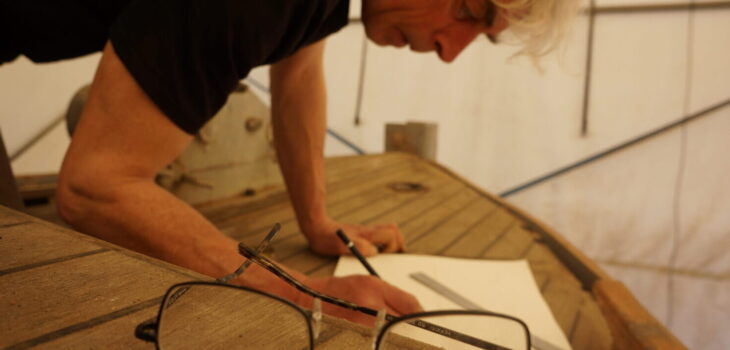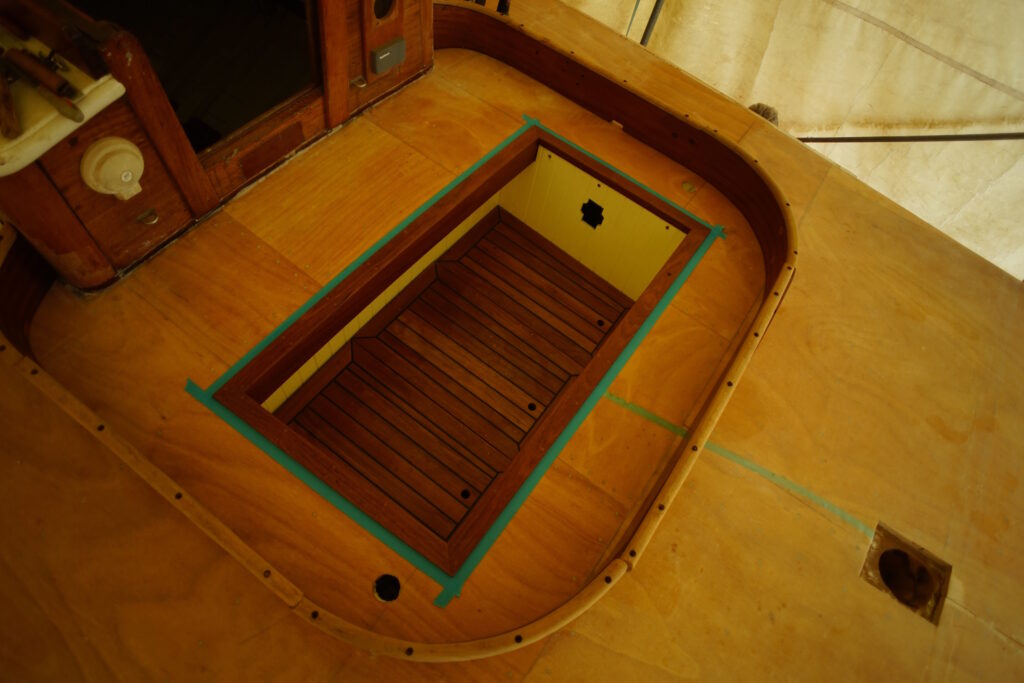 Restoration
Restoration
New deck and rudder, 2016
In Spring 2013 we turn our attention back to the deck, partly removed in 2007. There are several options to consider and it’s another three years before the deck is finally laid.
After considerable research and having some test pieces of the old teak deck sawn at the woodyard in Tansley, a decision is made. The remaining foredeck will have to come off, allowing for a complete new marine ply sub-deck, a layer of glass to ensure we have no leaks, then the sawn teak could be re-laid, or we could paint the glass in the style of a cloth or linoleum deck.





Looking back to when ‘Cachalot’ was built, Francis B. Cooke discusses various options for decks on small boats, referencing the approach taken by renowned marine artist Arthur Briscoe.
Nothing looks smarter than a nice deck of narrow planks shaped to the contour of the yacht and set off with teak covering board and king plank, but to my mind they are out of place in a small single hander, as they require much care and attention to keep them nice. Moreover, the decks of a small yacht are seldom very thick, and soon begin to open and leak. It is far better to go to the expense of covering the decks with linoleum, which, if well laid, looks very neat, and will keep them perfectly tight. If the owner does not care to go to the expense of covering the decks with linoleum they can be kept tight by paint, but personally I prefer linoleum, which, although rather expensive to lay, will last for years.
To fit out a yacht on these lines calls for a good deal of courage on the part of the owner, whose friends will tell him that it is a shame to cover up good wood with paint. I only know of one owner who has gone the whole hog in this respect, and that is Mr. Arthur Briscoe, who paints the decks, spars, blocks, and fittings of his fine 20-ton cutter ‘Golden Vanity’. He uses a shade of buff for the purpose, which looks extremely well; in fact, at a few yards distance one could not tell that they were not varnished. Mr. Briscoe has his reward when it comes to fitting out. All he has to do is to apply a coat of paint and the yacht is ready for the season. Few men get better value out of his boats than he, for he lives aboard for the greater part of the year and cruises all round the coast and across the Channel and the North Sea, in search of subjects for his brush, for, as most people know, he is a very clever marine painter.
Francis B Cooke, ‘Single-handed Cruising’, published 1919
After more discussions, sucking of teeth and research into the definitive plan for the deck, it’s decided: marine ply and glass, painted to provide the look of canvas. Steve starts fairing the deck beams, having completed all the jobs it’s easier to do without the deck on. Water and fuel tanks are thoroughly cleaned, and securely installed along with a new fuel filter.
On 22 July, 2015 ten boards of plywood arrive on a large lorry from Lathams. After stacking it safely, we hear Marion and Ian are stormbound on ‘Eleanor’ in Ipswich, they cycled round to see the boat and invited us back for supper. Beverley takes a week out to join James on ‘Kestrel’ in the OGA August Classics, while Steve is persuaded by Wendy that he must forgo sailing and get on with the deck. Did he really promise that ‘Cachalot’ will ready for the August Classics, 2016? Steve makes great progress with the deck boards and bulkheads, all grooved and painted ready for fixing. Autumn looks set fair for us to keep working into October, so we order 20 metres of glass with two-pack epoxy and put a thermometer on the coachroof to monitor temperature in preparation for glassing the deck.
The final week of September finds Steve completing the preparation of the deck, and with bulkheads installed, we’re ready for our lesson from James, kitted out in very fetching protective clothing. Everything has been carefully masked off, materials and tools all readily available, scaffold planks alongside the hull for fairly easy access and plans on how to glass the deck without getting ourselves into too many sticky corners! Bev is assigned as glue mixer, which is OK at first, but once there’s only the two of us it becomes much more stressful . . . after four sessions, the job is done and ‘Cachalot’ is wrapped up in her ‘inner tent’ for winter!
With the beginning of May 2016 looking promising, Steve goes down to Woodbridge. After doing his best with repairs to the tent, he concentrates on the boat, removing all the ‘peel ply’, filling the blemishes and finally sanding the newly-glassed deck. Almost ready for buying the paint, a trip to Larkmans confirms the colour. James is finishing the deck of ‘Charm’: International Sand it is. Next job is the rubbing strake, carefully crafted from larch and fixed along both sides from stem to just past the cockpit coaming. A visitor passes complimentary comments on the fair of the hull.
Back in March 2008, Steve made a new rudder, having sourced some elm from a Derbyshire woodyard. Constructed in the newly-built garden workshop at home in Matlock Bath, those were the days when we thought the project would not be quite such a ‘long haul’! After storage under the boat in Suffolk for eight years, it’s time to set the rudder in place. June 2016 found Steve tidying up the rudder stock and fitting the ‘boot’, then hanging the rudder to make sure it could swing freely.


Steve carefully mitres teak edges for all the through-deck fittings. There’s the cockpit to finish off with teak edging, before sanding down the coaming, hoisting it up onto the deck again, and setting it in place to bolt in and seal. By August 2016 with the deck and hull all done, there’s just the bulwarks before we can varnish and paint her for the winter. Steve starts with the reclaimed counter section, strong, laminated and possibly original. He makes a new set of knees to secure it firmly to the deck and makes good progress – it’s great to see the counter restored (almost) to her former glory! Next it’s replacements for the port and starboard sides, and the capping rail.








After careful measuring, a stock of iroko is purchased from Thorogoods, sufficient for the new bulwarks as well as the capping rail. It’s all sticked up ready, beside the tent . . . but what’s the best way to secure the new bulwarks to the deck? After much discussion, with various people, and several mock-ups and drawings, Steve starts production of 14 stanchions to sit neatly beneath the capping rail.


Making the stanchions takes quite a while, and was interrupted by a few days out sailing with the OGA for the August Cruise. It was great to welcome a crowd of gaffers at the tent on 22 August, 2016 even though she’s not in the water, we kept our promise of beers a-plenty! Bending on the iroko for the bulwarks went well, and by the beginning of September the deck was looking pretty shipshape – just needing the capping rail and enough good weather into the autumn to allow us time to paint and varnish ready for winter.